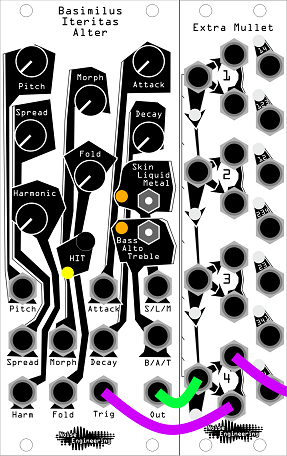Using Stuff Wrong, Episode 4: BIA drones and feedback patching
Welcome back to my personal favorite series, Using Stuff Wrong, where we use stuff in ways that they weren’t exactly intended to be used! Today, we’ll be talking about a couple of ways to use the Basimilus Iteritas Alter as a slightly terrifying drone machine. Let’s go!
How to drone with the BIA
We’ve mentioned in the past that the BIA responds to audio-rate triggers. This means that if you patch up an oscillator to the input, the BIA will trigger away at audio rates, creating some interesting melodic tones. The extra fun part of this is that you get completely different sounds out of it depending on what type of oscillator you put into it. A simple choice, of course, is just a square wave, which is effectively just a bunch of really fast triggers. However, if we put something like the Loquelic Iteritas Percido into it… things start to get wild.
Learn more:
We don’t have to use complex waves, though: the Ataraxic Translatron is my personal favorite oscillator to use as a sync source because of the unusual pulse patterns that come out of it. You can also use something like a normal square wave and a probability skipper: this will skip some of the pulses, giving us a less predictable and more varied signal. Integra Funkitus is great for this as it can run at audio rates and the T mode acts as a simple skipper with variable probability. You could also use just one output of Mutable Instruments Branches, or any other skipper module that can run at audio rates. Let’s try that out:
We can even use another triggered voice like the Manis Iteritas as our “sync” source. MI can freerun and act like a normal oscillator, which gives us some pretty gnarly results when used as our trigger source, but we can also reactivate its envelope and trigger it to turn this BIA/MI combo into a new voice completely. Whoa!
You may notice that when using an external oscillator like this, we’re getting results similar to oscillator sync: some of the pitch information from the triggering oscillator is carried over into what we hear as it’s shaped by the BIA.
And while those are some interesting patches, we can get even more creative and cut out the middleman here. To drone our BIA, all we need is a mult and two patch cables:

By splitting the BIA’s output and patching one copy back into the trigger input, we can get some really, really weird-but-cool results. Just tap the HIT button and the BIA will be off. It responds in really interesting ways to some tweaking, so play around with your settings, pitch, and mode. We’ll take a look at how that sounds in just a second, but first...
Don’t forget the modulation!
Drones are well and good on their own, but slow modulation can really bring them to life. My personal favorite CV generators for this sort of thing are Pons Asinorum and Clep Diaz. Pons Asinorum’s cycles can be extremely long, especially with external CV, and CD responds in interesting ways to slow and/or randomized clocks in LFO mode. Any kind of modulation will work, though: patch some CV into the BIA’s inputs and see what happens!
Let’s hear it
Here we go. We’ve split BIA’s audio out and one copy is going back into the trigger input. The other is going into the Desmodus Versio (COMING SOON), then to a compressor, then to our mixer. Modulation from PA brings in some nice change in our drone.
Be warned, this patch seems to have unleashed some sort of unhappy minor demon that was hiding in the BIA this whole time…
Your turn
Try this at home kids! Any oscillator will work. Try a VCA’d oscillator or complete voice for bursts, a free-running oscillator for drones, whatever you have. Each one will produce slightly different results and will be infinitely tweakable -- now you have all the BIA parameters AND the parameters of your second oscillator to play around with. Mind blown? Good. Class adjourned.





